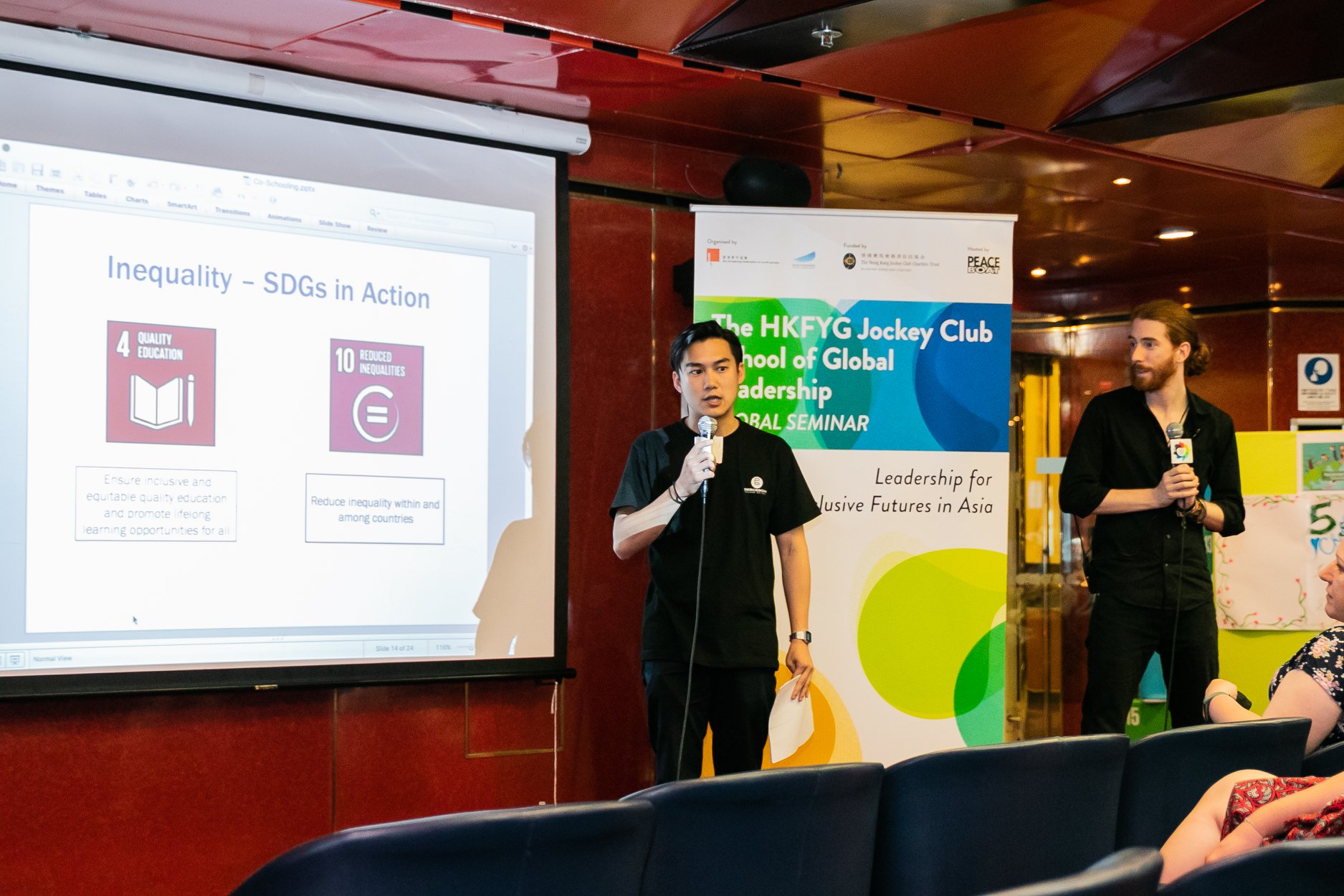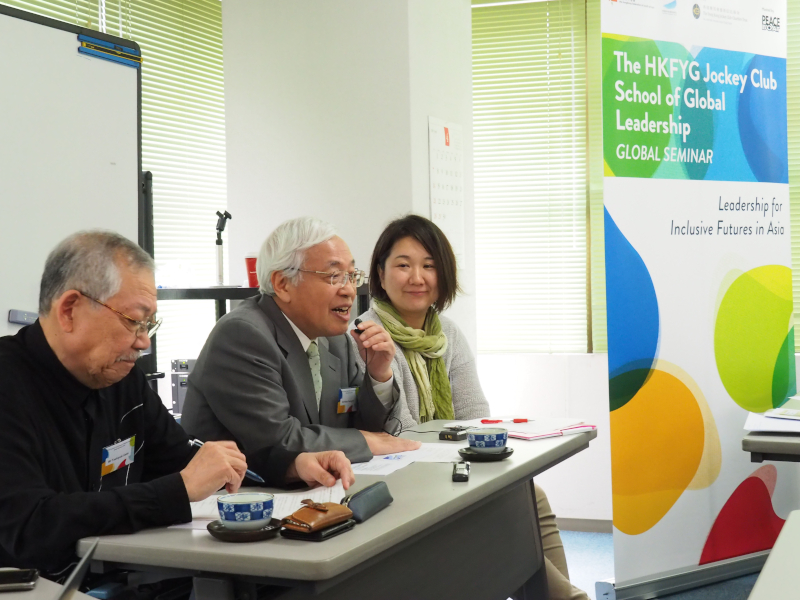
Programme participants gather to celebrate the UN Sustainable Development Goals
From the Ship
“Leadership for Inclusive Futures in Asia” - The Hong Kong Federation of Youth Groups Leadership Institute's Global Seminar on board Peace Boat
Peace Boat partnered for the first time with the Hong Kong Federation of Youth Groups (HKFYG) Leadership Institute to host The HKFYG Jockey Club School of Global Leadership - Global Seminar 2019. The seven-day Global Seminar took place from April 19 to April 25, 2019, with two days of fieldwork in Osaka, in-depth seminars and workshops centered around the Sustainable Development Goals (SDGs) held on board Peace Boat, and a closing session held in Hong Kong. The theme of the seminar was “Leadership for Inclusive Futures in Asia” with 23 young trisector professionals participating from seven different countries and regions.
At the heart of this programme lies Peace Boat’s commitment to creating people-to-people connections to facilitate peace and build a more sustainable future. In the programme, the 17 SDGs were grouped into five key pillars: Environment, Economy, Poverty, Equality, and Peace. The 23 participants were assigned a pillar and over the course of the programme took up the challenge of developing a project or service idea as a form of action tackling SDGs-related issues.
The programme started with two days of fieldwork in Osaka, which explored the central idea underpinning the SDGs that “no one will be left behind.” Osaka is one of the biggest cities in Japan, which has benefited greatly from the post-war economic growth. Yet, there are people who have been left behind, or considered “disposable.” By visiting various organizations in Osaka, participants strived to gain a deeper grasp of what we can do as a society to help ensure no one is left behind. In particular, through gaining hands-on experience in the fieldwork, participants were able to listen to the stories of people facing these problems and assess their needs.
Global Leadership Seminar participants learn about environmental protection countermeasures implemented by the city of Osaka.
Many of the participants found it surprising that a centuries-old class system (Buraku) could still be causing inequality in Japan’s modern society. Because of discrimination, many Buraku people struggle to get access to quality education and stable jobs. During an exchange with local organization, NICE, participants were able to see urban development initiatives first hand, such as its programmes to integrate immigrants into the community and increase tourism, which are helping to decrease stigma and promote the local economy. In the fieldwork, participants also witnessed how Japan’s postwar economic growth relied on day labourers, who engaged in unstable and risky jobs with little protection and no support network. Many former day labourers are currently homeless. Kamagasaki Shien Kiko’s work support programme and initiatives revealed how much effort and resources are required to support the daily lives of the homeless community, leading participants to discuss whether it would be more sustainable to ensure stable employment and a safe working environment for everyone to begin with.
During the programme the group also had the opportunity to visit Sanno Kodomo Center, an after school programme for underprivileged children, and Coco Room, another local NGO that is striving to provide a communal space where everyone is able to access media resources, express themselves and share their stories with one another. The community in this area is an exemplary model of what it means to take a proactive approach to urban development and self-sufficiency. They have managed to bridge the gap in social systems where governmental support is not sufficient and have proven that cohesive civil action can create a lasting impact.
As a culmination the fieldwork, participants visited the Aozora Foundation where they learned about the environmental pollution of the Nishiyodogawa area and the lawsuit that followed, as well as about the trisector alliance of the community, corporations and government that was vital to reach reconciliation and eventually restoration of the environment. A former Kobe Steel Litigation Officer and the head of the Association for Pollution Victims held a dialogue providing an inside view to the corporate reaction to the lawsuit, the hardship experienced by victims, and the thirty-year long path to reconciliation. Afterwards, Ministry of Land, Infrastructure, Transport and Tourism (MLIT) officers took participants on a walking tour of the area and introduced them to environmental pollution countermeasures being implemented in the area such as green zones, a road pricing scheme, and new technology such as active carbon fiber. Cooperation between government, civil society and the private sector is easier said than done. However, the kind of partnership that has come out of the Nishiyodogawa pollution case certainly inspired many participants.
A former Kobe Steel Litigation Officer and the head of the Association for Pollution Victims speak to participants about the Nishiyodogawa pollution lawsuit.
After two days of fieldwork in Osaka, the participants embarked on Peace Boat to engage in four days of intensive workshops and seminars where they utilized their experience in the field to create viable solutions to the issues that they had witnessed firsthand. In this process, Oshidari Kenro, Former World Food Programme Regional Director for Asia, and Gina Pulawska from the Asia-Europe Foundation (ASEF) supported participants as programme navigators (guest educators). Kenro gave workshops on topics such as leadership, negotiation and communication based on his 30 years of field experience with the WFP. Gina gave workshops and facilitated discussion on environmental sustainability based on her extensive experience facilitating multi-stakeholder platforms on the SDGs.
Vince Siu then led the groups through the process of design thinking in order to aid them in the creation of their projects. Each of the groups from the five pillars conducted surveys, gathered information, and developed innovative solutions such as a smartphone application to monitor air-purifying plant health in the home, initiatives to connect the elderly and youth to ensure the transfer of generational knowledge and combat loneliness, and the use of the five senses to reconnect people with nature. Participants had the opportunity to share their work with their fellow passengers through presentations and booths set up in the communal space on board.
 Programme participant Chris Pang and his group present their SDG pillar (Inequality) to Peace Boat participants.
Programme participant Chris Pang and his group present their SDG pillar (Inequality) to Peace Boat participants.
During their time at sea the group also had the opportunity to hear from other guest speakers such as Fukatsu Takako, a Certified Teacher of the Association Montessori Internationale, and Ada Ho, Founder and CEO of internet startup Paxxioneer. Takako strongly believes that peace begins with children, and the Montessori education method allows children to develop their innate talents and interests which in turn become essential building blocks to develop a peaceful society. In contrast, Ada spoke about the importance of leadership and some of the best practices and policies when it comes to being a leader in the workplace or in the home.
In addition to hearing from a diverse group of navigators, participants were able to immerse themselves in the multicultural and multigenerational environment that is the foundation for Peace Boat’s unique platform as a forum for promoting dialogue, peace and cross-cultural exchange. On the 101st Voyage are roughly 1,100 passengers from 17 different countries and regions, with the youngest passenger being two years old and the oldest passenger 94 years old. In everyday life on land, there is not an opportunity to meet and connect on a deep level with such a plethora of people with varied backgrounds and life experience. Peace Boat is similar to a small floating village where people live, work, and learn together. In such environment, participants were able to view the world from new perspectives, gain insight, and participate in open dialogue which creates deep-rooted bonds.
Members of the SDG pillar, Economy, work to develop a smartphone application to monitor air-purifying plant health in the home as an alternative to traditional electric air purifiers.
The Global Seminar ended with a special closing session in Hong Kong after disembarkation. In addition to the participants, there were many local people from Hong Kong from the public and private sectors, as well as other international guests. The closing session was a unique opportunity for participants and facilitators alike to look back on the programme, strengthening their resolve to continue their work in relation to the SDGs and actualize the projects they began on board.
In order to create a truly peaceful and sustainable society, we must not only educate ourselves, but we must also proactively take action to create the future that we desire. The tri-sectoral collaboration of the Global Seminar brought together 23 immensely talented youth leaders who were able to develop innovative solutions to complex issues. Without the collaboration of leaders in the private, public and civil sectors, we will be unable to achieve the lofty goals we have set as a society and run the risk of becoming victims of our own hubris. As a dedicated campaigner for the SDGs, Peace Boat will continue to work towards building a peaceful and progressive society and we look forward to hosting future programmes to foster the growth of the leaders of tomorrow.




